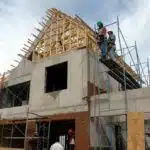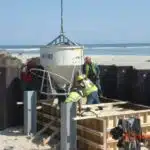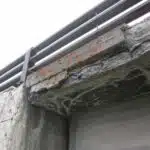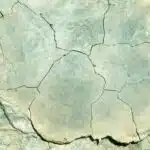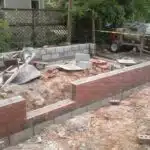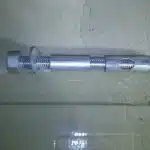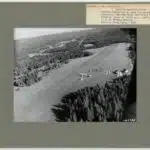Pouring concrete in cold weather can be a daunting task for many construction professionals. The low temperatures and freezing conditions can alter the properties of the concrete mix, leading to cracks and other structural defects. However, with proper preparation and execution, it is possible to pour high-quality concrete even in sub-zero temperatures.
As a concrete construction specialist, I have spent years perfecting the art of pouring concrete in cold weather. In this article, I will share my insights and tips on how to prepare for and execute a successful concrete pour in cold weather conditions. Whether you are a seasoned professional or a novice in the construction industry, this guide will provide you with valuable information on how to safely and effectively pour concrete in cold weather.
Understanding The Challenges Of Pouring Concrete In Cold Weather
Concrete is like a living organism, it requires proper care and attention to thrive. Pouring concrete in cold weather poses challenges that can negatively impact the concrete’s strength and durability. The concrete temperature during the pour should be between 50°F and 60°F to ensure proper curing. However, the ambient temperature outside can often be much lower than this range during winter months, making it difficult to maintain the desired temperature.
When pouring concrete in cold weather, there are several factors to consider. One of the most critical factors is the effect of freezing temperatures on fresh concrete. If the concrete freezes before it has had a chance to cure properly, it can result in cracking or even complete failure of the structure. Another factor to consider is the additional time required for the concrete to set and cure in colder temperatures. This may extend project timelines and increase costs.
It is essential to have a thorough understanding of these challenges before attempting to pour concrete in cold weather conditions. Proper planning and preparation are critical for ensuring success. This includes taking steps such as selecting appropriate materials, using insulating blankets, adjusting mix designs, and implementing proper curing techniques. By taking these precautions, you can ensure that your project will withstand harsh winter conditions and provide long-lasting results.
Importance Of Proper Planning And Preparation
Proper planning and preparation when pouring concrete in cold weather is essential in order to achieve a successful result. Materials should be planned in advance to ensure that they are of the highest quality, and appropriate for the environmental conditions. The surface should be adequately prepared to create a suitable base, and allow for proper adhesion and a stronger bond between the concrete and the surface. Temperature control during the process should be carefully monitored to avoid frost damage and cracking. Heating equipment should be available onsite to maintain the desired temperature of the concrete and surrounding environment. By following these preparation guidelines, the quality of the concrete can be improved and the risk of failure can be significantly reduced.
Planning For Materials
Concrete pouring in cold weather can pose a significant challenge for construction specialists. The success of the project largely depends on proper planning and preparation, particularly when it comes to selecting the right materials and budgeting for them. Material selection is critical as it directly affects the workability and the setting time of the concrete. In cold weather, high early strength concrete or accelerators are typically used to speed up the rate of hardening. Additionally, anti-freezing agents may be added to prevent freezing of water in the mixture.
Budget planning is another crucial aspect that needs careful consideration before starting any concrete project in cold weather conditions. Since cold weather affects the setting time of the concrete, additional manpower and equipment may be required to keep up with the pace of work. This could impact overall costs significantly if not properly accounted for at the outset. It is important to factor in these additional expenses while creating a budget plan so that unexpected expenses do not arise during or after the project.
In conclusion, planning for materials involves making smart choices that will ensure successful completion of any concrete project in cold climates. Proper material selection and budget planning are key factors that contribute towards achieving this goal. With careful planning, construction specialists can minimize risks associated with working in adverse weather conditions and deliver quality end products that meet safety standards and client expectations alike.
Preparation Of Surface
As a concrete construction specialist, it is imperative to understand the importance of proper planning and preparation when working in cold weather conditions. One crucial aspect that needs careful consideration is the preparation of the surface where the concrete will be poured. Surface preparation involves ensuring that the surface is clean, dry, and free from any contaminants that may affect adhesion. Moisture management is also critical as excess moisture can cause a host of problems, including cracks, spalling, and decreased durability.
To achieve optimal surface preparation, it is important to start by cleaning the surface thoroughly to remove any dirt, debris, or loose particles. Any oil or grease stains should be removed using specialized cleaners before proceeding with any further steps. Once cleaned, the surface should be allowed to dry completely before proceeding with any further steps. Adequate drying time varies depending on temperature and humidity levels but typically takes 24-48 hours.
After ensuring that the surface is clean and dry, measures should be taken to manage moisture levels effectively. This could involve using sealants or coatings designed to prevent moisture ingress from below or above the surface. Alternatively, installing a vapor barrier beneath the concrete slab can also help prevent moisture-related issues down the line. Proper preparation of the surface ensures that concrete projects in cold climates are successful and meet industry standards for quality and safety.
Temperature Control
As a concrete construction specialist, understanding the importance of proper planning and preparation when working in cold weather conditions is crucial. Surface preparation is one aspect that needs careful consideration to ensure successful and safe projects. In addition to surface cleaning and moisture management, temperature control also plays a significant role in achieving optimal results.
In cold weather conditions, it is essential to maintain the appropriate temperature throughout the curing process to prevent issues such as cracking or reduced strength. Thermal blankets and heating systems are two effective ways of controlling temperatures during curing. Thermal blankets provide insulation to retain heat while heating systems can warm up the surrounding air or ground beneath the concrete slab.
Proper temperature control during curing not only ensures that the concrete reaches its desired strength but also prevents any potential safety hazards on site. As a concrete construction specialist, it is crucial to plan for proper temperature control measures before starting any project in cold weather conditions. By doing so, you can guarantee quality and safety standards are met while serving your clients’ needs.
Choosing The Right Concrete Mix
Proper planning and preparation are crucial when pouring concrete in cold weather. However, choosing the right concrete mix is equally important to ensure that it can withstand the harsh conditions. Factors such as strength, water-cement ratio, and air content must be considered when selecting a concrete mix for cold weather applications.
Strength is an essential factor when choosing a concrete mix. The colder the temperature, the longer it takes for concrete to cure and gain strength. Therefore, a higher strength mix should be used to compensate for the extended curing time. A water-cement ratio of 0.45 or less is also recommended because too much water can weaken the mixture and cause cracking during freezing and thawing cycles. Additionally, air-entrained concrete with 6% to 7% air content should be used to allow room for expansion during freeze-thaw cycles.
Testing and evaluating options are necessary when selecting a concrete mix for cold weather applications. Various mixes have different properties that affect their performance in low temperatures. By conducting tests such as slump tests, compressive strength tests, and air content tests on available options, you can make informed decisions about which one will work best in your specific situation.
By considering factors such as strength, water-cement ratio, air content, testing and evaluating options before starting your project, you can choose the right concrete mix that will perform well in cold weather conditions. In the next section, we will discuss how using additives can enhance cold weather performance even further.
Using Additives To Enhance Cold Weather Performance
- Accelerators may be used to reduce the time needed for concrete to set during cold weather.
- Anti-Freeze agents are used to decrease the risk of freezing temperatures causing the concrete to expand and crack.
- Retarders are used to slow down the rate of hydration in order to prevent the concrete from setting too quickly in cold weather.
- The use of accelerators, anti-freeze agents, and retarders must be carefully calculated in order to ensure the concrete meets industry-standard performance requirements.
- In addition to these additives, the concrete mixture should be modified to protect against the effects of cold temperatures on the hydration process.
- The concrete should be adequately covered and insulated to ensure the mixture does not become too cold before it has fully set.
Using Accelerators
As concrete construction specialists, we understand that pouring concrete in cold weather can be a challenge. One effective approach to enhance its performance is by using accelerators. Accelerators are additives that speed up the setting time of concrete, allowing it to reach its strength faster.
There are various types of accelerators available in the market, and each type has different dosage requirements. Some common accelerator types include calcium chloride, non-chloride accelerators, and aluminum sulfate. Calcium chloride is widely used due to its low cost and availability. Non-chloride accelerators are preferred for high-strength concrete as they do not react with steel reinforcement. Aluminum sulfate is commonly used in precast applications as it produces a quick set without compromising the quality of the finished product.
Dosage requirements for accelerators depend on several factors such as cement type, temperature, and project specifications. A general rule of thumb is to use one to four percent by weight of cement for calcium chloride and 0.1 to 2% for non-chloride accelerators. It is important to follow manufacturer instructions when determining dosage requirements as excessive use may lead to a decrease in strength or other undesirable effects.
By using proper accelerator types and following dosage requirements, we can effectively enhance the performance of concrete in cold weather conditions. As construction professionals, it is our duty to provide high-quality work that meets client expectations while ensuring safety on site.
Using Anti-Freeze Agents
As concrete construction specialists, we are constantly looking for ways to enhance the performance of concrete in cold weather conditions. One effective approach is by using additives such as accelerators and anti-freeze agents. While accelerators speed up the setting time of concrete, anti-freeze agents prevent freezing and thawing cycles from damaging the concrete.
There are various types of anti-freeze agents available in the market, including calcium chloride, sodium chloride, and potassium acetate. These agents lower the freezing point of water in the mix, preventing ice crystals from forming and damaging the concrete. However, there are also drawbacks to using these agents. For example, calcium chloride can corrode steel reinforcement if used excessively. Additionally, some anti-freeze agents may cause discoloration or affect the setting time of concrete.
Despite these drawbacks, using anti-freeze agents can provide several benefits in cold weather conditions. By preventing freezing and thawing cycles from damaging the concrete, we can ensure a longer lifespan for our projects. It also allows us to continue working during colder months without sacrificing quality or safety on site. As construction professionals who prioritize quality and safety above all else, incorporating anti-freeze agents into our practices is just one way we strive to serve our clients’ needs effectively.
Using Retarders
As concrete construction specialists, we continually seek ways to enhance the performance of concrete in cold weather conditions. One effective approach is by using additives such as accelerators and anti-freeze agents. While accelerators speed up the setting time of concrete, anti-freeze agents prevent freezing and thawing cycles from damaging the concrete. In this article, we will discuss another type of additive that can be used in cold weather conditions: retarders.
Using concrete accelerators can be beneficial in cold weather, but it can also cause problems if not used appropriately. The fast-setting nature of accelerated concrete can result in cracking or shrinkage if forms are not removed quickly enough. This is where using retarders comes into play. Retarders slow down the setting time of concrete, prolonging its workability and allowing more time for proper placement and finishing.
Choosing appropriate forms for a project is crucial when using retarders as an additive. Since these additives slow down the setting time of concrete, it is essential to select forms that can withstand prolonged exposure to wet concrete without warping or bending. Additionally, care must be taken to ensure that these forms are properly sealed to prevent moisture from penetrating the surface and causing damage.
In conclusion, using retarders as an additive in cold weather conditions offers several benefits for our projects’ quality and safety. By slowing down the setting time of concrete, we have more time for proper placement and finishing while avoiding cracking and shrinkage issues caused by fast-setting accelerated concrete. Choosing suitable forms is critical when incorporating retarders into our practices, ensuring a durable structure that withstands harsh weather conditions.
Preparing The Site For A Cold Weather Concrete Pour
Site preparation is essential for a successful cold weather concrete pour. Before any pouring can take place, the site must be properly cleared of all debris and leveled to ensure an even surface. It is also important to make sure that the site is free from any potential hazards such as tree roots or large rocks that could interfere with the placement of the concrete.
Another critical aspect of site preparation in cold weather conditions is ground thawing. Frozen ground can cause many problems during a concrete pour, including uneven settling and cracking. To combat this issue, it is necessary to heat the ground using various methods such as propane heaters or electric blankets. Ground thawing should be done well in advance of the pour to allow for proper drying time and to prevent any damage to the soil.
Proper site preparation and ground thawing are crucial steps in ensuring a successful cold weather concrete pour. Taking the time to prepare the site correctly will not only result in a better-quality finished product but will also help prevent accidents and injuries on the job site. In the next section, we will discuss how to ensure adequate protection for workers and equipment during a cold weather concrete pour.
Ensuring Adequate Protection For Workers And Equipment
After preparing the site for a cold weather concrete pour, it is essential to ensure adequate protection for workers and equipment. Protective gear such as insulated clothing, gloves, and boots should be worn by all workers on site. It is also important to ensure that all equipment used in the concrete pouring process is properly maintained and functioning correctly.
In addition to protective gear and equipment maintenance, there are other measures that can be taken to protect workers and equipment during a cold weather concrete pour. One effective method is the use of temporary enclosures or heated tents to provide shelter from the elements. These structures can help maintain a consistent temperature and protect workers and equipment from snow, wind, and other harsh weather conditions.
Another important consideration is monitoring weather conditions throughout the pouring process. This includes keeping an eye on temperature changes as well as any precipitation or winds that may affect the curing process. By staying vigilant of these factors, construction specialists can make adjustments as necessary to ensure a successful cold weather concrete pour.
To continue with ensuring a successful cold-weather pour, it is imperative to monitor weather conditions closely. This will allow us to make adjustments as necessary throughout the pouring process while ensuring that all protective measures are in place for both workers and equipment.
Monitoring Weather Conditions
It is crucial to monitor the weather conditions before undertaking any concrete construction project. In cold weather, the impact on the concrete mix can be significant, leading to inferior quality and even structural failure if not addressed correctly. It is imperative to use state-of-the-art weather monitoring tools that provide accurate data about temperature, wind speed, humidity levels, and precipitation.
Cold weather concreting strategies are essential for ensuring that the concrete mix remains within acceptable limits during placement and curing. One such strategy is using insulating blankets and heating coils to maintain the required temperature range of 50-70°F for proper curing. Additionally, a specially formulated mix with high early strength gain additives can be used to combat the effects of low temperatures on concrete.
Proper monitoring of weather conditions during cold weather concreting can make all the difference in achieving a successful outcome. By utilizing advanced technology and effective strategies for mixing and placing concrete in cold weather environments, one can achieve superior results while minimizing potential risks associated with inadequate preparation or execution.
Transition: Now that we have discussed monitoring weather conditions in cold weather concreting let us move on to controlling the temperature of the concrete mix.
Controlling The Temperature Of The Concrete Mix
Monitoring the weather conditions is essential to ensure that the concrete mix is poured appropriately. However, it’s equally important to control the temperature of the concrete mix to prevent it from freezing in cold weather. It’s imperative to keep the concrete mix warm during transportation and placement as low temperatures can cause delayed setting time and reduced strength.
Mix temperature control is one of the most crucial aspects of cold weather concreting. The American Concrete Institute (ACI) recommends maintaining a minimum concrete temperature of 50°F (10°C) during placement and for three days after placement. To achieve this, heating equipment such as insulated blankets or heating coils can be used to maintain the temperature of the fresh concrete mix. Additionally, preheating aggregates and water before mixing can also help increase its temperature.
Curing techniques must also be adapted for cold weather concreting to ensure proper strength development. In colder temperatures, concrete takes longer to cure and gain strength than in warmer weather conditions. Therefore, curing methods such as using insulating blankets, straw bales or other enclosures can help retain heat and moisture in the concrete for an extended period. This will promote proper curing and ensure that the desired strength is achieved within a reasonable timeframe.
Adapting techniques for cold weather concreting requires careful consideration of various factors that can impact its quality and durability. By monitoring weather conditions, controlling mix temperature, and adapting curing techniques, we can overcome challenges posed by cold weather conditions and produce high-quality concrete structures even during adverse environmental conditions.
Adapting Techniques For Cold Weather Concreting
Adapting techniques for cold weather concreting is essential to ensure a successful project. The first step in adapting techniques is to consider the equipment requirements. Concrete that is mixed in colder temperatures will require more water to achieve the same workability as concrete mixed in warmer temperatures. It is also important to use insulated blankets or heated enclosures to keep the concrete at an optimal temperature during curing.
Timing considerations are equally important when pouring concrete in cold weather. Concrete must be poured during daylight hours, preferably when temperatures are above freezing and rising. This will allow sufficient time for proper placement, finishing, and curing, which can take longer in colder weather. Pouring concrete too late in the day may result in it freezing before it has had time to cure properly.
Common issues that arise when pouring concrete in cold weather include cracking and shrinkage. To prevent these issues, it is recommended to use air-entrained concrete, which contains tiny air bubbles that help relieve internal pressure caused by temperature changes. Additionally, it is important to ensure proper curing by using insulating blankets or heated enclosures around the concrete slab for several days after placement.
Transition: Using insulating materials to protect the concrete can further aid in preventing cracking and shrinkage. Let’s explore this technique further.
Using Insulating Materials To Protect The Concrete
As the weather gets colder, concrete pours become more challenging. However, by adapting techniques for cold weather concreting, you can ensure a successful pour. One effective method is using insulating materials to protect the concrete from freezing temperatures.
When selecting insulating materials, it’s important to consider their thermal conductivity and thickness. Materials with low thermal conductivity are more effective at reducing heat loss during curing. Additionally, thicker insulation provides better protection against temperature fluctuations. Commonly used insulating materials include polystyrene foam board, blankets made of fiberglass or mineral wool, and straw bales.
Application techniques also play a crucial role in ensuring proper insulation. The insulation should be placed around the perimeter of the concrete slab and secured in place with stakes or weights to prevent it from shifting during the pour. It’s also essential to cover any exposed surfaces of the insulation to prevent moisture intrusion and maintain its effectiveness.
Proper selection and application of insulating materials are critical steps in cold weather concreting that can help ensure a successful pour. In the next section, we will discuss covering and curing the concrete properly to further protect it from cold weather conditions.
Covering And Curing The Concrete Properly
The covering and curing process is vital to ensure that the concrete maintains its strength and durability. Once you have poured the concrete, it is essential to cover it properly with a curing blanket, tarpaulin, or straw to protect it from the cold weather. The covering should remain in place for at least three days after pouring the concrete. It will help retain moisture and heat within the concrete while allowing it to set correctly.
After removing the cover, you must begin curing the concrete. Curing is a process that allows the concrete to dry slowly over time, which strengthens its internal structure. You can cure your concrete by spraying water on it regularly or by using an appropriate curing compound. Concrete sealing techniques are also useful during this phase as they prevent moisture loss from the surface of the concrete.
Time management during the curing process is crucial because if done incorrectly, it can lead to defects such as shrinkage cracks and surface scaling. The curing period should last between seven and 14 days depending on factors such as temperature, humidity, wind speed, and mix design. It would be best if you also avoided exposing your newly cured concrete to heavy loads or traffic until it has reached its full strength capacity. By following these guidelines for covering and curing your concrete correctly, you will ensure that your project remains structurally sound for years to come.
Transition: Now that we have covered how to cover and cure your cold weather concrete correctly let us move on to addressing common issues and defects that can occur during this process.
Addressing Common Issues And Defects
As a concrete construction specialist, addressing common issues and defects is crucial to ensure the durability and quality of the final product. Common mistakes in concrete pouring include improper mixing, inadequate curing, and overworking the concrete. These mistakes can result in defects such as cracking, scaling, and spalling.
Prevention techniques for these issues include ensuring proper water-to-cement ratio during mixing, providing adequate curing time for the concrete to reach its full strength, and avoiding overworking the surface. It is also important to use high-quality materials and follow best practices for placement and finishing.
Dealing with unexpected weather conditions can also pose challenges in cold weather concrete pouring. It is important to monitor weather forecasts closely and take appropriate measures such as using insulating blankets or heaters to maintain proper temperatures during curing. Additionally, it may be necessary to adjust the mix design or timing of placement to accommodate for factors such as temperature fluctuations or precipitation.
As a concrete construction specialist, attention to detail and proactive measures are key components in avoiding common issues and defects in cold weather concrete pouring. By implementing prevention techniques and being prepared for unexpected weather conditions, we can ensure a high-quality finished product that will withstand the test of time. In the next section, we will discuss safety considerations for cold weather concrete pouring.
Safety Considerations For Cold Weather Concrete Pouring
When addressing common issues and defects in concrete pouring, it is important to consider the impact of cold weather on the process. Pouring concrete in colder temperatures can pose several challenges that require different approaches to ensure a successful pour. However, safety must always be the top priority when working with concrete in any conditions.
Safety precautions are especially crucial during cold weather concrete pouring. Workers should wear appropriate protective gear such as insulated clothing, gloves, and boots to minimize exposure to the cold. In addition, it is essential to provide adequate lighting and heat sources to prevent accidents and hypothermia. Proper training on handling equipment and materials in these conditions is also necessary to reduce the risk of injuries.
In summary, safety considerations are paramount for successful cold weather concrete pouring. Protective gear and proper training are essential for workers’ well-being while working in low temperatures. By taking necessary precautions before starting a pour, accidents can be prevented, ensuring a safe work environment for everyone involved. Next, we will discuss how cleaning and maintaining equipment after the pour is equally important for safety reasons.
Cleaning And Maintaining Equipment After The Pour
After the concrete pour, it is important to clean and maintain all equipment used during the process. Equipment should be cleaned promptly to ensure that the concrete does not harden on the surfaces, which can make cleaning more difficult. This step is crucial as it helps extend the lifespan of your tools, reduce downtime due to repairs, and ensures high-quality work.
To clean equipment such as mixers, trowels, and floats, use a hose to rinse off any remaining concrete. Be sure to remove any excess water from the equipment before storing it away. This will prevent rusting or damage from moisture buildup. After rinsing, wipe down all surfaces with a damp cloth or sponge to remove any remaining residue.
Equipment storage is also an essential aspect of maintaining your tools after a concrete pour. Store all equipment in a dry place where they will not be exposed to rain or moisture. Storing your tools properly will help keep them in good condition and ready for use when you need them again. Additionally, proper storage can help prevent accidents caused by misplaced tools.
- Properly label all equipment for easy identification.
- Place tools on racks or shelves rather than leaving them on the ground.
- Cover equipment with tarps or plastic sheets to protect them from dust and debris.
- Schedule regular maintenance checks for machinery.
- Dispose of any leftover concrete safely, following local regulations for disposal.
With proper care and maintenance, your equipment will last longer and perform better over time. Cleaning and storing your tools correctly after each use is critical for ensuring their longevity and avoiding unnecessary downtime due to repairs or replacement needs. By following these steps, you can help ensure that your concrete construction projects are successful every time you take on one.
As we have seen how important it is to properly maintain our equipment after pouring concrete in cold weather conditions let’s move on to discuss best practices for success in cold weather concrete pouring.
Best Practices For Success In Cold Weather Concrete Pouring
The frigid weather can be unforgiving to concrete pouring. As a concrete construction specialist, one must take precautionary measures before proceeding with the project. Preparing for cold weather conditions is crucial to ensure the success of the job.
Firstly, it is essential to have all equipment requirements ready and in good condition. The tools used in concrete pouring must be suitable for cold weather use. Warm water, heating blankets, insulated tarps, and windbreaks are some necessary equipment that can keep the temperature of the concrete stable during cold weather conditions. All equipment should be inspected thoroughly before starting any work.
Secondly, additional precautionary measures should be taken during the actual pouring process. The temperature of the air and ground should not fall below 40°F (4°C) while pouring and curing the cement mixture. Concrete should be kept warm by using insulating blankets or sheets until it cures adequately. It is also recommended to avoid placing concrete on frozen ground as it could cause cracking and weakening of the structure.
In conclusion, pouring concrete in cold weather conditions requires proper planning and execution. Failure to take necessary precautions could lead to significant delays, increased costs, or worse yet, structural damages due to improper curing of the cement mixture. By following these best practices for success in cold weather concrete pouring, one can ensure a successful project outcome that will stand up against harsh winter conditions for years to come.
Conclusion
Pouring concrete in cold weather presents unique challenges that require careful planning and preparation. Understanding the impact of temperature on the curing process is crucial in selecting the right mix and additives to ensure a successful pour. When preparing the site, it is essential to take into account factors such as wind, humidity, and ground temperature. Addressing common issues such as cracking and scaling requires meticulous attention to detail during the pouring process.
One interesting statistic shows that concrete poured at temperatures below 50°F takes twice as long to cure compared to concrete poured at 70°F or higher. This means that cold weather can significantly delay construction projects, leading to increased costs and potential safety hazards. As a concrete construction specialist, it is our responsibility to ensure that we follow best practices for cold weather pouring to minimize these risks.
By utilizing proper techniques and equipment, mitigating common defects, and prioritizing safety measures, we can successfully pour concrete in cold weather conditions. It is crucial to consider all aspects of the process from start to finish, including cleaning and maintaining equipment after use. With a strategic approach and attention to detail, we can overcome the challenges of cold weather pouring while ensuring quality results for our clients.
Image Credits
- “Concrete pouring” by H. Raab (User:Vesta) (featured)



